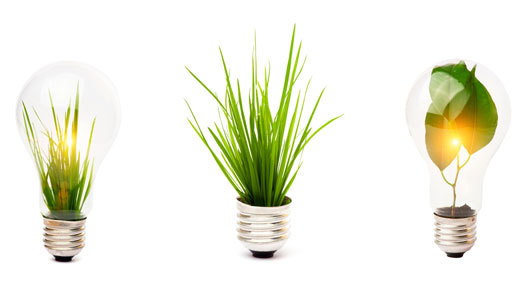 Lightbulbs with Plants, with permission from Shutterstock
Lightbulbs with Plants, with permission from Shutterstock
“These are my principles. If you don’t like them, I have others.” Groucho Marx could also have been talking about environmental standards. Our world is so awash in eco-communication that it’s hard to make sense of the many competing claims. Citizens are confronted by a mass of labels that make claims about the environmental attributes of different products: Organic, Fairtrade, FSC Certified, "sustainable."
The tendency of politicians to dissemble adds uncertainty — vague promises to use, "as few natural resources as possible," "reduce waste to a minimum," or (this one from the UK) to deliver the "greenest Olympics planned so far," amplifies our suspicion that not enough is being done. This blizzard of vague assertions is confusing and in some cases, intentionally so. Some companies advertise products and services with environmental claims that are false, unsubstantiated or unethical. In the US, for example, where 43 per cent of Americans say they are changing their lifestyle to be "more green," an official-looking Eco Certificate can be purchased for as little as $400.
The term greenwashing applies when companies spend more money asserting their green credentials than they do changing their practices. Greenwashing often involves changes to the brand communications and packaging.
"A thief who tells a judge he is stealing less than before will receive no leniency. So why do companies get environmental awards for polluting less, even though they are still polluting?" The biomimicry entrepreneur Gunther Pauli is scornful of the "do less bad" school of environmentalism. It's not sufficient to know that a new product is more sustainable than its competitor. Even 50% more sustainable is meaningless in the absence of a reliable benchmark.
For designers and their clients, advantage will accrue to those who use numbers, not adjectives. How much matter, water and energy has it taken to design, produce and use a product or building? What is the economic and social cost? Product communications need to state what will be sustainable, while being specific about benchmarks.
What matters is less how information is presented, than what is being counted and how the numbers are used. Despite the global economic crisis, the trajectory of the Dow still shapes how many people, perceive the economy in particular: up is good, down is bad. The flaw with the Dow is that its "up" describes increases in energy and resource flows that are devastating the biosphere.
Tools are becoming available to help companies measure their impact on ecosystems. For example a report called 'The Economics of Ecosystems and Biodiversity' (TEEB) by Pavan Sukhdev, published by Deutschebank and the European Commission, promotes a better understanding of the true economic value of the benefits a business receives from nature. "Nature provides human society with a vast diversity of benefits such as food, fibers, fuel, clean water, healthy soil, protection from floods, protection from soil erosion, medicines, storing carbon (important in the fight against climate change) and many more,” says Sukhdev. “Though our well-being is totally dependent upon these ecosystem services, they often are not detected in company information." Thirty other tools and metrics to help companies measure their impact on ecosystems are on the horizon.
The transition to sustainability is not about messages, it's about activity. Most professional designers are in the representation business, so their first response has been to design a poster about sustainability or launch a media campaign. But emitting messages, however clever or evocative they may be, is not the same as helping companies change an aspect of their everyday material reality.
This essay was originally published in Domus, December 2, 2010.
